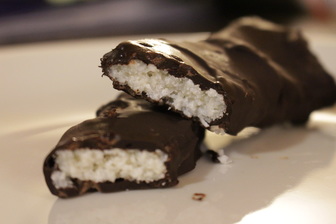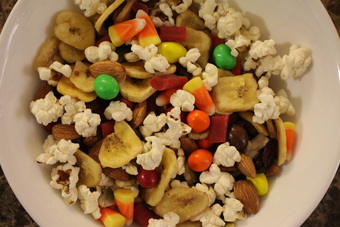|
Halloween is fast approaching! Other than the costumes and scary movies, one essential thing most people talk about during this time of year is the TREAT! I believe there is nothing wrong with having some treats to put you in the Halloween spirit. However, as for everything else, balance is key. Here are some tips to help you have a healthier Halloween: a) DIY Chocolate Bars! Do-it-yourself chocolate bars are perfect treats to bring to your Halloween get-togethers or to make for trick-or-treating (if you decide to give out candies). These recipes are easy to make. They do not contain any processed and random, hard to pronounce ingredients typically found in store-bought chocolate bars. Homemade Reese’s Peanut Butter Cups Ingredients: 300 g Semi-Sweet Chocolate Chips Peanut Butter - I chose the low-fat version. Additional: cupcake baking cups and a cupcake muffin pan Directions: 1) Place each baking cup on the cupcake muffin pan. This will help create the unique circumference seen in the original Reese’s Peanut Butter Cups. 2) Melt the chocolate chips. 3) In each cup, add 1 teaspoon of the melted chocolate and spread equally and evenly. This will be the bottom layer. Put in the freezer for 10 minutes. 4) Remove from the freezer. Add one teaspoon of peanut butter on each cup. Make sure not to spread it too much because you don’t want it to be visible from the outside. Freeze again for 10 minutes. 5) Remove from the freezer. Add two teaspoons of melted chocolate on top. Make sure to even out this last layer by spreading it to the edges. This will be your top layer. Freeze for 20 minutes and you’re done! Enjoy! Homemade Bounty Bars Ingredients: 2 cups of Unsweetened Medium Desiccated Coconut ½ cup of Melted Coconut Oil 3 tablespoons of Maple Syrup or Honey 250 g Dark Chocolate Chips Additional: parchment paper and a baking pan Directions: 1) Using a mixer or a food processor, blend the desiccated coconut, coconut oil, and maple syrup for 5-7 minutes on a medium or high speed. Final product is good if it sticks together when squeezed. 2) Line a pan with parchment paper. Place the coconut mixture on the baking pan. I suggest making the layer thick so it won’t break easily after. Freeze for 30 minutes. 3) Melt the dark chocolate chips. 4) Remove the coconut layer from the freezer and cut them into your preferred size. 5) Line another baking pan with parchment paper. Coat the sliced coconut layers by dipping them into the dark chocolate mixture. Place the final product on the parchment paper. Freeze for an hour (or until the chocolate hardens) and you’re done! Enjoy! b) Make a Snack Mix with your Leftover Candies Aside from the tricks Ben talked about in ESN’s new Halloween Youtube video, making a snack mix is another way to use leftover Halloween candies.  For my snack mix I combined pumpkin seeds, raw almonds, dried banana slices, dried cranberries, stovetop popcorn and Halloween candies (candy corn, M&Ms, and Nibs Twizzlers) together. Aside from the candies, my favourite ingredient in this mix is the stovetop popcorn! The media loves to showcase popcorn as this “unhealthy” and “buttery” movie snack. This makes most people think of popcorn as junk food — convenient and soaked in butter. However, in its natural form popcorn is a whole grain. It is high in insoluble fibre which helps digestion. I like to cook my popcorn with canola oil or coconut oil because they are perfect for high temperature cooking. Stovetop popcorn is about 55 calories for 1 cup. This is a healthy alternative to microwavable popcorn which contains artificial flavour and colour, and preservatives. Oil-popped popcorn is a nutritious snack as long as it contains a moderate amount of butter and other toppings. Mixing your leftover Halloween candies with healthy ingredients will help control how much candy you’re eating. Furthermore, leftover candies add fun and variety to your favourite trail mix ingredients. I hope these tips are helpful! As always, be aware of portion sizes and take a moderate approach when eating your Halloween candies! If you haven’t seen it yet, make sure to watch ESN’s Halloween Video Thanks for reading. Have safe and happy Halloween! Gelaine Trinidad, BASc Social Media Coordinator for Evolved Sport and Nutrition
4 Comments
jho
3/11/2016 10:07:01 am
Will definitely try this with all my favourite candies. Thanks for the healthy alternative of indulging in that Halloween goodness!
Reply
15/5/2023 08:21:14 am
To specify a specific Java Runtime Environment (JRE) for Pale Moon to use, you can follow these steps:
Reply
Leave a Reply. |
Categories
All
Archives
November 2021
|
- Home/ News
- About
- Services/ Store
- Media
-
Learning Center
- ESN Athletic and Healthy Lifestyle Learning Center >
-
Professional Learning Center
>
-
The ESN Sports Nutrition Certificate
>
- ESN Learning Center - Sports Nutrition Certificate Level 1 >
- ESN Learning Center Sports Nutrition Certificate Level 2 >
-
ESN Learning Center - Sports Nutrition Certificate Level 3
>
- Module 1 - Periodization for the Athlete
- Module 2 - Nutrition Strategies to Optimize Recovery
- Module 3 - Sports Nutrition for Children and Young Athletes
- Module 4 - Sports Nutrition for the Aging Athlete
- Module 5 - Nutritional Strategies for Injury Prevention and Concussions
- Module 6 - Nutritional Strategies for the Travelling Athlete
- Module 7 - Tournament Nutrition Strategies
-
The ESN Sports Nutrition Certificate
>
- Contact
Proudly powered by Weebly




 RSS Feed
RSS Feed